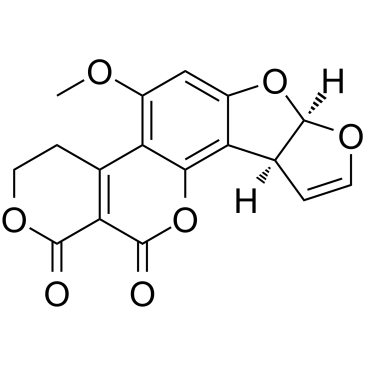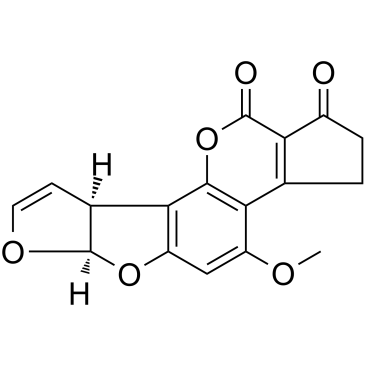Aflatoxin G1

Aflatoxin G1 structure
|
Common Name | Aflatoxin G1 | ||
|---|---|---|---|---|
| CAS Number | 1165-39-5 | Molecular Weight | 328.273 | |
| Density | 1.6±0.1 g/cm3 | Boiling Point | 612.1±55.0 °C at 760 mmHg | |
| Molecular Formula | C17H12O7 | Melting Point | 244-246ºC | |
| MSDS | Chinese USA | Flash Point | 274.1±31.5 °C | |
| Symbol |



GHS02, GHS07, GHS08 |
Signal Word | Danger | |
Use of Aflatoxin G1Aflatoxin G1 is one type of aflatoxins occuring in nature. It is produced by molds, such as Aspergillus flavus and Aspergillus parasiticus. Aflatoxins are hepatogenic, teratogenic, imunosuppressive, and carcinogenic fungal metabolites found in feeds, nuts, wine-grapes, spices, and other grain crops[1][2]. |
| Name | Aflatoxin G1 |
|---|---|
| Synonym | More Synonyms |
| Description | Aflatoxin G1 is one type of aflatoxins occuring in nature. It is produced by molds, such as Aspergillus flavus and Aspergillus parasiticus. Aflatoxins are hepatogenic, teratogenic, imunosuppressive, and carcinogenic fungal metabolites found in feeds, nuts, wine-grapes, spices, and other grain crops[1][2]. |
|---|---|
| Related Catalog | |
| References |
[1]. Sarma UP, et al. Aflatoxins: Implications on Health. Indian J Clin Biochem. 2017 Jun;32(2):124-133. |
| Density | 1.6±0.1 g/cm3 |
|---|---|
| Boiling Point | 612.1±55.0 °C at 760 mmHg |
| Melting Point | 244-246ºC |
| Molecular Formula | C17H12O7 |
| Molecular Weight | 328.273 |
| Flash Point | 274.1±31.5 °C |
| Exact Mass | 328.058289 |
| PSA | 84.20000 |
| LogP | -0.17 |
| Vapour Pressure | 0.0±1.8 mmHg at 25°C |
| Index of Refraction | 1.680 |
CHEMICAL IDENTIFICATION
HEALTH HAZARD DATAACUTE TOXICITY DATA
MUTATION DATA
|
| Symbol |



GHS02, GHS07, GHS08 |
|---|---|
| Signal Word | Danger |
| Hazard Statements | H225-H304-H315-H319-H340-H350-H372 |
| Precautionary Statements | P201-P210-P301 + P310-P305 + P351 + P338-P308 + P313-P331 |
| Personal Protective Equipment | Eyeshields;Gloves;type P2 (EN 143) respirator cartridges |
| Hazard Codes | T: Toxic;T+: Very toxic;F: Flammable;Xn: Harmful; |
| Risk Phrases | R45 |
| Safety Phrases | 53-28-36/37-45-62-26-16-7-36 |
| RIDADR | UN 3462 6 |
| WGK Germany | 3 |
| RTECS | LV1720000 |
| Packaging Group | I |
| Hazard Class | 6.1(a) |
|
~% 
Aflatoxin G1 CAS#:1165-39-5 |
| Literature: Mutation Research, , vol. 313, # 1 p. 25 - 38 |
|
Development and validation of an UHPLC-MS/MS method for the determination of mycotoxins in grass silages.
Food Addit. Contam. Part A. Chem. Anal. Control. Expo. Risk Assess. 32 , 2101-12, (2015) An ultra-high-performance liquid chromatography-tandem mass spectrometry (UHPLC-MS/MS) multi-mycotoxin analytical method was developed to simultaneously identify and quantify 20 mycotoxins in grass si... |
|
|
A multi-analyte LC-MS/MS method for the analysis of 23 mycotoxins in different sorghum varieties: the forgotten sample matrix.
Food Chem. 177 , 397-404, (2015) An LC-MS/MS method was developed and validated for the detection and quantification of 23 mycotoxins in different varieties of sorghum. The method performance characteristics were as follows: suitable... |
|
|
Stability of aflatoxins in solution.
J. AOAC Int. 95(4) , 1084-8, (2012) The stability of aflatoxins B1, B2, G1, and G2 was studied in solutions containing different concentrations of water, acetonitrile, and/or methanol, and in autosampler vials treated with nitric acid o... |
| AF G1 |
| MFCD00005089 |
| Aflatoxin G(1) |
| 1H,12H-Furo[3',2':4,5]furo[2,3-h]pyrano[3,4-c][1]benzopyran-1,12-dione, 3,4,7a,10a-tetrahydro-5-methoxy-, (7aR,10aS)- |
| aflatoxin g1 solution |
| AFLATOXIN G |
| EINECS 214-615-9 |
| Aflatoxin G1,crystalline |
| (7ar-cis)-10a-tetrahydro-5-methoxy |
| 10a-tetrahydro-5-methoxy |
| Aflatoxin G1 |
| (7aR,10aS)-5-Methoxy-3,4,7a,10a-tetrahydro-1H,12H-furo[3',2':4,5]furo[2,3-h]pyrano[3,4-c]chromene-1,12-dione |


